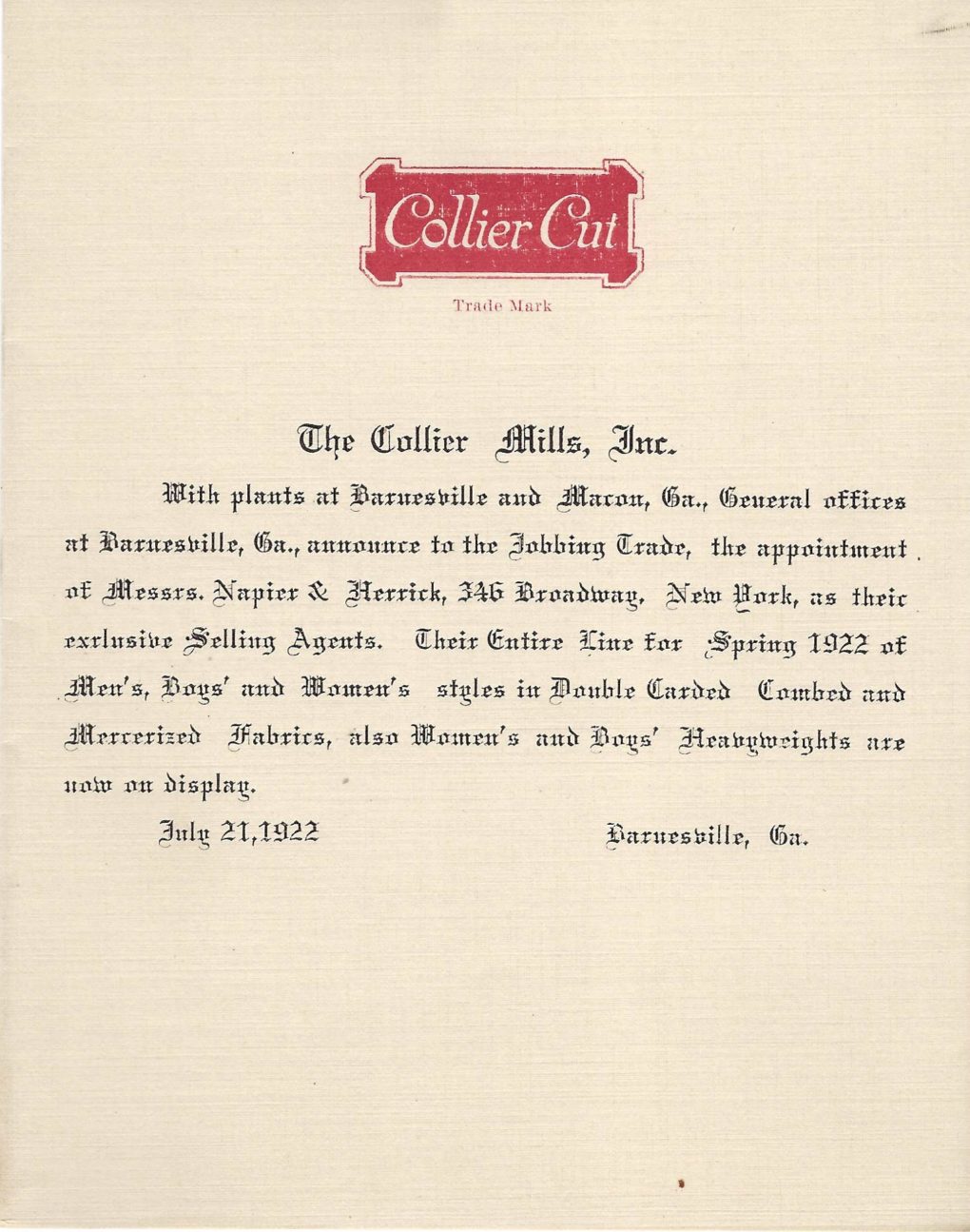
April 6, 2017 marked the 100-year anniversary of the entry of United States into World War I. This post documents the involvement of Collier Manufacturing Company in the war effort.
In early 1918, the United States was gearing up to send troops to Europe. By the summer of 1918, US involvement would see approximately 10,000 Americans arrive on the continent each day. To outfit and supply the troops required a massive effort.
To that end, in spring of 1918, representatives of the US War Department approached Collier Manufacturing of Barnesville, Georgia, to supply the army with knit undershirts. According to an affidavit by J. C. Collier, President of Collier Manufacturing Company at the time, the government officials advised the textile manufacturer to work through Clift and Goodrich of New York, instead of directly for the government. The main reason for this was that Clift and Goodrich, regular sellers for Collier Manufacturing, had already posted a bond with the War Department, so much time could be saved by eliminating the time-consuming red tape of applying for a new bond.
Collier Manufacturing installed equipment for making the undershirts. According to government specifications, the garments were light-weight, short-sleeve pullovers, probably similar to today’s T-shirts. Clift and Goodrich secured three contracts dated March 7, May 7, and June 11, 1918. Each contract was for 120,000 undershirts. The price was for 52-1/2 cents per undershirt for the first contract, 56 cents for the second and 58 cent per garment for the third.
The first 60,000 undershirts were inspected, with only 6 garments being rejected (one every ten thousand), and shipping orders were issued by the government. By July 2018, the company had produced enough undershirts to fulfill almost all of the first two contracts, but the government was lagging behind in providing inspections and approving shipping orders. The accumulated undershirts congested available space at the mill, slowing production of these and other garments. Finally, in response to numerous complaints, the government sent three inspectors to the mill. Using testing and methods later deemed to be completely inappropriate by the government, the inspectors rejected many of the undershirts so that on September 5, 2018, the company was notified no more shipments would be accepted “until satisfactory garments could be delivered.” In October with the end of the War in sight, the War Department terminated the contracts with Clift and Goodrich. World War I ended three weeks later on November 11, 2018. Collier Manufacturing did not find out about termination of the contracts until May 14, 1919, some seven months after the contracts had been cancelled.
Collier Manufacturing sought to recover its losses through every available means. They filed suit against the US Government in 1923, seeking over $61,000 in compensation.
suit against US - petition reduced2
Collier Mfg vs US request for findings reduced
The company sought legislative action. Here is the report of a US Senate Subcommittee hearing on February 14, 1934 on Bill S. 2242, “A Bill for the Relief of Collier Manufacturing Company of Barnesville, Georgia.”
1934_02_14_Senate Subcommittee Hearing reduced2
The Bill passed out of the Senate Committee on Claims on May 10, 1934 with the loss amount reduced to $48,719.70. The Committee did not allow interest charges built into the original bill.
1934_05_10_Senate Committe Report reduced
The US Senate approved the Bill but it failed to pass the House of Representatives. It was resurrected in 1936 as Bill S. 1431.
1936 Memo in Support S 1431 reduced
Senate Bill S. 1431 (An Act for the Relief of Collier Manufacturing Company of Barnesville, Georgia) which authorized the Secretary of the Treasury to compensate Collier Manufacturing $48,719.70 for its losses was passed by both the US Senate and the House of Representatives in 1936 . . .
. . . only to be vetoed by President Franklin D. Roosevelt.
1936_06_01 veto reduced
FDR dismissed the Collier bill with a regular veto. Online sources report Roosevelt used the regular veto 372 times during his 4 terms of office.
But that wasn’t the end of the story. Neither was successful, but similar bills were presented before the Senate in 1937 and the House of Representatives in 1949 (over 30 years after the end of WWI).
Here is the Senate Bill (S. 1866).
1937_03_15_Senate Bill S 1866 reduced
And House Bill H.R. 5079.
1949_06_ Rep. Camps HR Bill 5079 reduced
And the unsigned Affidavit of J. C. Collier that was prepared in 1941. J. C. Collier died in 1944, prior to submittal of the 1949 Bill..
JCC Affidavit reduced2
High resolution copies of the above documents may be downloaded here:
Click Here
































Fancy drawers! I love the woven labels especially, for some reason.
Looking over the pictures, I wonder if the “8 point” referred to the eight buttons located strategically on the suits? They appear to be comfortable and the picture of the actual suit looks like tee-shirt material.